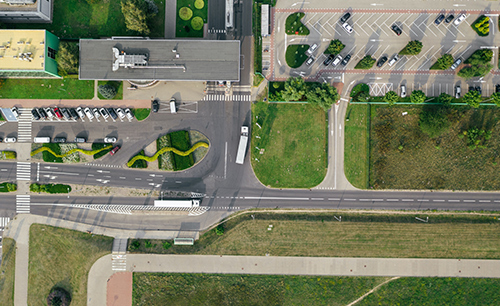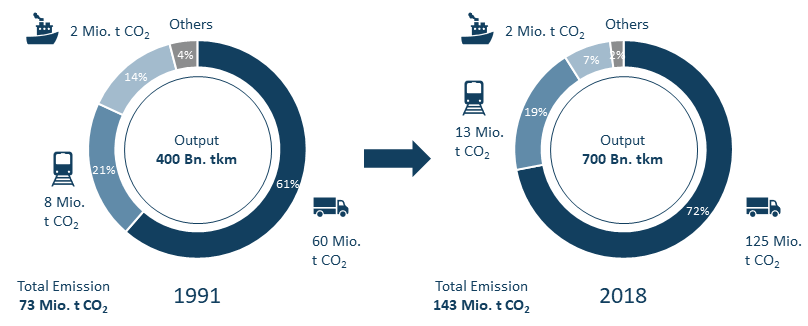
Green Logistics
Although Green Logistics has many synonyms such as Sustainable Supply Chain Management (SSCM) or sustainable logistics, it has one common goal: to protect the environment and for the transport of goods to cause as little damage as possible. This goal intrinsically includes sustainable production. A sample calculation to get a feeling of the magnitude:
Before it was even in your possession, your cell phone had already seen the entire world. This is because of the 62 chemical elements on average that it is composed of. A cell phone contains about 10g copper, 0.1g titanium, 0.05g cobalt, 0.03g gold and about 0.005g gallium in combination with arsenic (gallium arsenide). The corresponding mining sites are, respectively, most common in Chile, Japan, Congo, Australia and Russia. Everything then comes together for further processing in East Asia, for example at Texas Instruments in the Philippines or at Osram in Malaysia. The production of a cell phone generates additional CO2 emissions of around 70kg (average values of the iPhone 11 - iPhone 5). This amount of emission corresponds to an empty journey of a 40t truck from Düsseldorf to Frankfurt (235km with 300g/km CO2 emission).
In this example, SSCM could be applied at numerous points:
- Local raw materials
SSCM can mean changing products and production to use fewer raw materials that have to travel long distances. - Centralized supply chains
SSCM can also mean bundling many production facilities in one or fewer locations, ideally close to consumers. - Sustainable means of transport
Ships have the greenest CO2 footprint with less than 50 g/tkm (tonne-kilometre), freight trains can emit over 100 g/tkm and trucks emit up to 250 g/tkm. Air freight causes CO2 emissions from 600 g/tkm (long-haul flights) to over 1,800 g/tkm (domestic flights). - Forward-looking logistics planning
The figures above make it clear: the faster the means of transport and the smaller the batch size, the more environmentally damaging it is. Conversely, emissions can be reduced through foresighted planning. However, the reality in Germany is that domestic goods transport is becoming increasingly damaging to the environment. In 2014, for example, transport via trucks was responsible for around 87 percent of CO2 emissions (1991: 82 percent), but only contributed 72 percent (1991: 61 percent) of the total transport volume (German Federal Environment Agency, own illustration):

- Less empty transport - export ≈ import
Did you know that every fifth truck you pass on the road is empty? The freight transport statistics for Germany 2018 show a total of 23.8 billion load kilometers and 6.6 billion empty kilometers (trucks only). In other words, 6.6 billion kilometers that do not add any logistical value. This corresponds to roughly 15 million tons of unnecessary CO2 emissions. To be sustainable, SSCM would also mean avoiding empty runs, which, for example, would result in longer standing times and is therefore, just like the points above, a question of money. - Night transport - not only CO2 is emitted
The supply chain also includes “the last mile”. In the B2C sector it is the way to the customer's front door, in the B2B sector it is the way to the point of sale. The latter rarely takes place at night, among other reasons because points of sale near the home are subject to certain noise restrictions. Reasonably, the worst thing for residents are truck doors that most exceed the permissible sound pressure level. Green Logistics does not only mean to focus on CO2 or other harmful gases. As in this example, completely different environmental impacts can also be taken into account. - Returns management
With the last mile, unfortunately, "the end" of the supply chain is seldom reached. Returns must also be considered. Just like a mountaineer: after reaching the summit, there is still some work left. There are roughly three possibilities for returns in e-commerce. You can integrate them back into the merchandise management system, you can offer them at a discount in the aftermarket (e.g. in outlet centers) or you can destroy them. According to reports, the latter is a common practice of Amazon, Otto and Zalando. The same reports estimate that today goods worth 7 billion EUR per year are destroyed in Germany.
These seven examples show some of the diversity around Green Logistics and SSCM... and with that, we haven't even talked about the working conditions of warehouse workers, subcontractors or other employees in the supply chain. It is already clear that SSCM must be viewed holistically, that organizations must develop agile, analytical approaches and that the cost-driven downward spiral of climate change can only be reversed with additional financial resources.
More Information
If you would like more information on this topic, please contact us. We are also happy to help you with all other questions within industrial market research and strategic consulting.Text written by Philipp Rosar